Grilling enthusiasts often aim for that perfect blend of juicy, tender, and flavorful meat. However, getting the desired results can be challenging without a trusty tool like a meat thermometer.
This blog post will explore “can you use meat thermometers on the grill” and how to achieve scrumptious steaks, burgers, and more effortlessly. We’ll also discuss different types of thermometers and how they work to make your grilling experience safer and tastier than ever before. So fire up your grill, and let’s dive in!
Understanding Types of Meat Thermometers
Meat thermometers come in two types: digital and dial, both of which are designed to measure the internal temperature of the meat.
Here are some common types of meat thermometers:
| Type of Meat Thermometer | Description |
|---|---|
| Leave-In Thermometers | Oven-safe or probe thermometers can be inserted into the meat and left in place while cooking. Ideal for monitoring internal temperature during roasting or grilling. |
| Digital Instant-Read Thermometers | Quick and accurate readout of the internal temperature within seconds. Great for checking multiple spots on grilled meats. |
| Disposable Pop-Up Thermometers | Single-use thermometers pop up when the appropriate internal temperature is reached, indicating the meat is perfectly cooked. Commonly used for poultry. |
| Infrared Thermometers | Non-contact devices measure surface temperature using infrared technology. Suitable for checking grill or pan temperatures, but not ideal for measuring internal meat temperatures. |
| Bluetooth/WiFi Smart Thermometers | Wireless devices allow you to monitor food temperature anywhere through a smartphone app. Perfect for tech-savvy grill masters. |
Knowing about the different types of meat thermometers helps you find the perfect tool for your grilling needs and preferences and ensures optimal taste, doneness, and safe cooking practices.
How Meat Thermometers Work
Meat thermometers are essential tools for grilling enthusiasts to ensure perfectly cooked meats every time. They come in two main types: analog (dial) thermometers and digital (probe) thermometers.
Dial thermometers use bimetal spring technology but can be less precise than digital models due to inconsistencies in expansion rates.
Digital probe thermometers are more accurate, with a precision of ±1°F, and some offer oven-safe probes for continuous monitoring.
When using a meat thermometer, remember to calibrate it before use and avoid opening the grill too often. This way, you’ll be able to enjoy delicious steaks and barbecued ribs all summer long.
Can You Use A Meat Thermometer For Grilling
You can use a meat thermometer for grilling to ensure your food reaches the proper temperature. Here are some types of meat thermometers suitable for this task:
Types of meat thermometers suitable for grilling:
1. Leave-in Thermometers: Those with thermometer probes can be inserted into a piece of meat before grilling and left in place throughout the process. They may also have a probe that can be left outside of the grill and connected to a remote display.
2. Instant-Read Thermometers: Fast thermometers must be inserted and removed quickly to prevent heat loss but provide accurate readings within seconds.
3. Wireless Thermometers: These thermometers have probes that can be inserted into the meat and placed on the grill while monitoring from a distance using a remote display.
Using any of these thermometers will help ensure food safety and get delicious results every time.
Proper Placement Of The Thermometer In Meat
Proper thermometer placement in meat is essential for a safe and delicious meal.
When grilling, you should insert the probe into the thickest part of the meat without touching any bones since they conduct heat differently and can give an inaccurate reading.
Also, when grilling large cuts like beef brisket or pork shoulder roast, use two probes – one at each end of the cut – to identify grill temperature differences between various parts of the meat that may cook at different rates.
This way, you’ll always achieve evenly cooked meats with optimal doneness.
Recommended Temperature Ranges For Different Types Of Meat
It’s important to follow recommended internal temperature ranges for various types of meat when grilling to ensure a safe and delicious meal. The USDA suggests the temperatures in the table below.
| Type of Meat | Recommended Internal Temperature |
|---|---|
| Beef, Pork, Veal, Lamb (steaks, chops, roasts) | 145°F (63°C) with a 3-minute rest time |
| Ground Meats (beef, pork, veal, lamb) | 160°F (71°C) |
| Poultry (whole, parts, ground) | 165°F (74°C) |
| Fish and Shellfish | 145°F (63°C) |
| Ham, pre-cooked (to reheat) | 140°F (60°C) |
By adhering to these recommended temperature ranges and using a meat thermometer when grilling, you can ensure your food is perfectly cooked while avoiding harmful germs.
Benefits Of Using A Meat Thermometer On The Grill
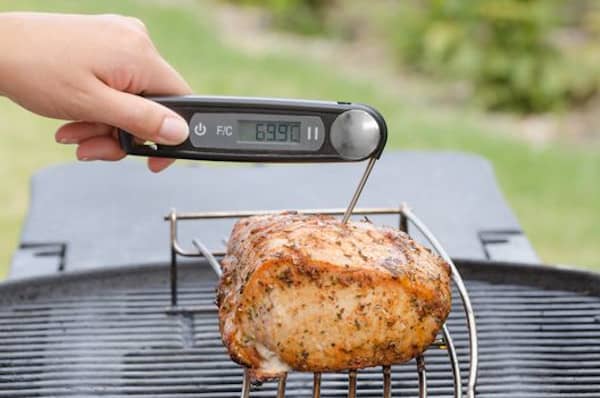
Using a meat thermometer on the grill has numerous benefits, from ensuring food safety to preventing overcooking and dryness.
Ensuring Food Safety
It allows you to monitor the internal temperature of the meat as it cooks, which helps avoid undercooked or raw meat that can contain harmful bacteria and overexposure to potentially dangerous chemicals produced by overcooked meats.
The USDA recommends cooking beef, pork, lamb, and veal steaks, chops, and roasts to an internal temperature of 145°F (63°C), while ground meats like burgers should be cooked to an internal temperature of 160°F (71°C), and poultry needs to reach at least 165°F (74°C).
Using a meat thermometer when grilling is essential for both safety and deliciousness.
Consistently Cooking Meat To Desired Doneness
Using a meat thermometer makes grilling consistent and safe. Insert the thermometer into the thickest part of the meat to get an accurate internal temperature and easily achieve rare, medium-rare, or well-done steaks.
For chicken breasts and pork chops, it’s especially important to use a thermometer to avoid undercooking, which can lead to harmful bacterial growth, or overcooking, which can result in dryness.
Investing in a quality food thermometer is key for grilling food perfectly every time.
Preventing Overcooking And Dryness
Using a meat thermometer on the grill eliminates the guesswork of grilling, helping to prevent overcooking and dryness.
With an accurate reading from the thermometer, you can keep meats juicy and tender by ensuring that they reach their recommended internal temperature range.
It gives you peace of mind when cooking meats like chicken or pork that require thorough cooking for food safety reasons.
A meat thermometer is truly essential for safe and delicious barbecued meals.
Avoiding Harmful Chemicals
A meat thermometer is essential in preventing exposure to potentially carcinogenic compounds such as heterocyclic amines (HCAs) and polycyclic aromatic hydrocarbons (PAHs) that form when meat is cooked beyond the recommended temperature range.
An advanced digital thermometer with Bluetooth connectivity can easily ensure accurately cooked results, leading to delicious grilled meals full of juicy flavors and avoiding harmful chemicals.
Tips And Tricks For Using A Meat Thermometer On The Grill
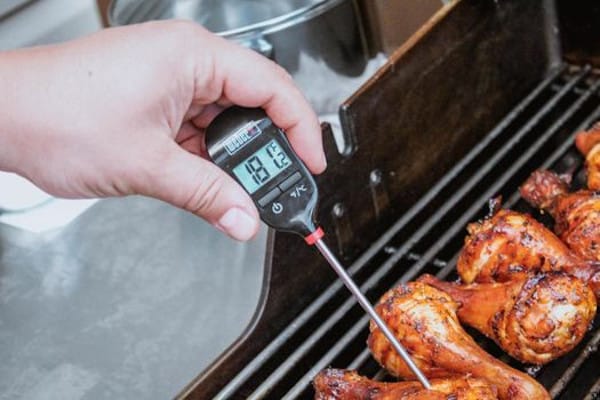
To ensure the accuracy of your meat thermometer, it is essential to calibrate it before use by inserting the probe into ice water and adjusting as necessary; also, avoid opening the grill too often during cooking, use a timer to keep track of cooking time, and make sure to clean and store your thermometer properly.
Calibrating Your Meat Thermometer Before Use
Calibrating your digital meat thermometer before each grilling session is essential for cooking to the desired doneness.
This can be done using either ice water or boiling water method and should be checked periodically to make sure it’s providing accurate readings.
Taking this extra step before every cook lets you enjoy perfectly cooked steaks, burgers, and other proteins without worrying about undercooking or overcooking them.
Avoiding Opening The Grill Too Often
Opening the grill lid too often is a common mistake beginner grillers make. It causes significant heat loss and prolongs cooking, making achieving proper doneness in your meats difficult.
To avoid this problem, ensure you know what temperature range you need for your meat and correctly position your thermometer.
Try not to peek at meats excessively since each time you open the lid, and you’re lengthening the required cooking times.
Using A Timer To Keep Track Of Cooking Time
Using a timer when grilling is essential to ensure you don’t overcook or undercook your food.
Many digital meat thermometers have built-in timers to set an alert once your food reaches the desired internal temperature or has been cooking for some time.
Alternatively, you can use a kitchen timer or even your phone timer.
Keeping track of both temperature and cooking time will allow you to control the grilling process better and enjoy perfectly cooked meats every time!
Cleaning And Storing Your Thermometer Properly
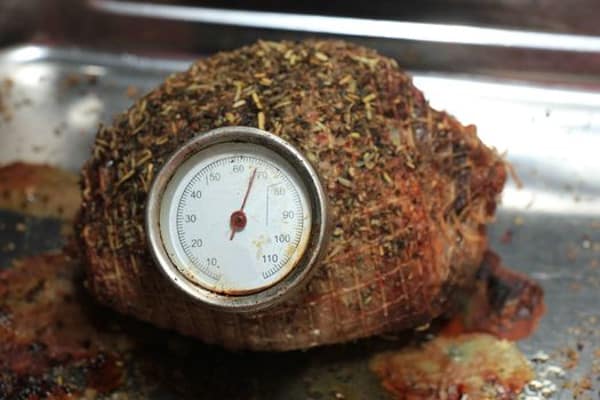
Properly cleaning and storing your meat thermometer is essential for ensuring its accuracy and extending its lifespan.
After each use, clean the probe with a damp cloth or paper towel. Avoid soaking the probe in water or using abrasive materials to clean it.
Store the thermometer in a dry and cool place away from direct sunlight, preferably in a protective case if one is provided.
Additionally, be careful when handling the device and avoid dropping it, as this can cause internal damage that may affect readings.
By taking proper care of your thermometer, you’ll enjoy accurate temperature readings and be able to use it longer.
Conclusion
Want to perfect your grilling skills? Use a meat thermometer! Understand its types, placement, recommended temperature ranges, and proper usage and maintenance.
This will help you always achieve the desired doneness while being safe. Plus, your taste buds (and stomach) will thank you.
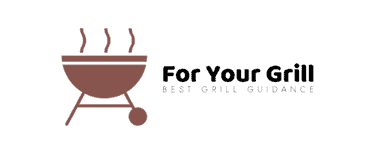

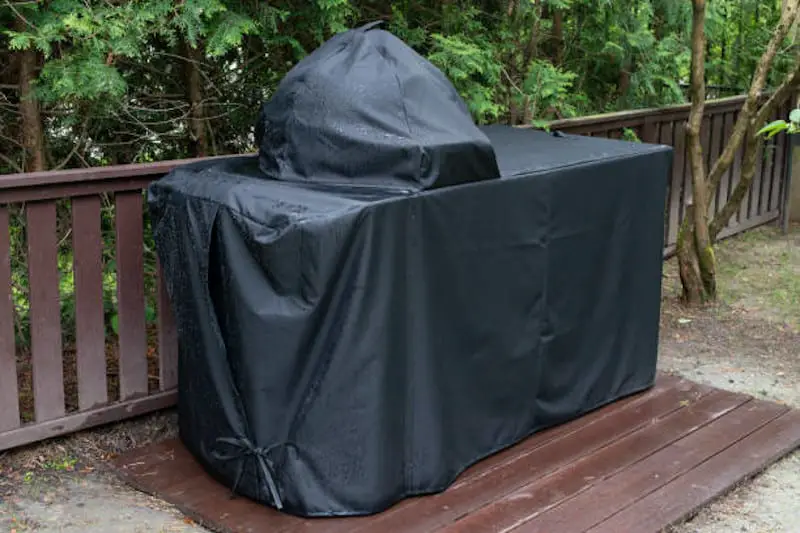

Leave a Reply